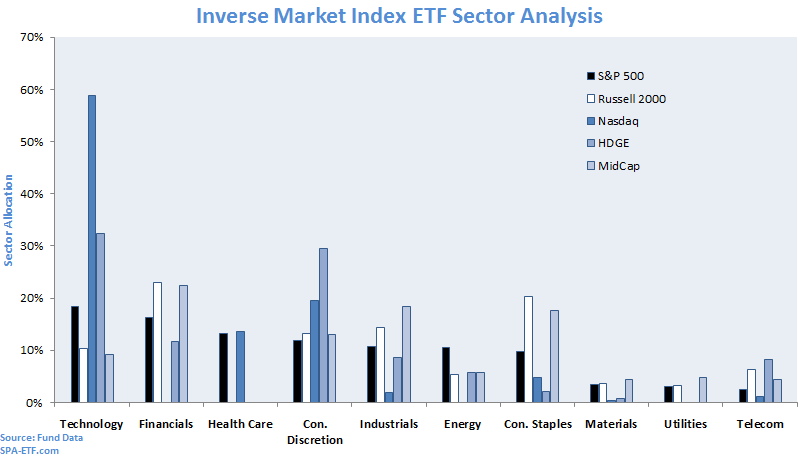Inverse ETFs Are The Best Play For A Falling Market
Post on: 12 Апрель, 2015 No Comment

Summary
- The market may be reaching a top.
- Shorting individual stocks is risky.
- Short ETFs allow investors to hedge with more security.
The stock market is logging record new highs seemingly every week, and the bullish sentiment appears unwavering. It may be darkest before the dawn, but it’s also brightest before dusk. It could be the right time for investors to consider a contrarian play.
Shorting a stock is a large risk for most investors, and utilizing options strategies can lead to complications for non-professionals and those not seeking a margin account. Hedging a portfolio against downside risk can be as easy as buying a stock through the use of ETFs, particularly inverse ETFs.
Inverse ETFs hold a short portfolio, allowing investors to take short positions without using margin, and risking only the amount of money used to buy the ETF. These ETFs are designed to return a profit equal to the decrease of the underlying index they are designed to match. For example, if the Dow drops by 1%, the inverse ETF would gain 1%. In practice, however, inverse ETFs are vulnerable to volatility loss due to the use of derivatives and the daily re-balancing of assets. This makes them more risky than their standard counterparts.
For investors looking to hedge their portfolio with inverse ETFs, there are three main asset risk categories to cover: stocks, foreign currencies, and interest rates. The best ETFs for these categories are ProShares Short S&P 500 ETF (NYSEARCA:SH ), ProShares UltraShort Yen ETF (NYSEARCA:YCS ), and ProShares Investment Grade-Interest Rate Hedged ETF (BATS:IGHG ).
ProShares Short S&P 500 is an ETF that seeks to short the S&P 500 index. Its average daily trading volume is over 3.8 million, making it highly liquid. It has an expense ratio of 0.95% and appears to be oversold, based on its RSI of 33. The long bull market has negatively impacted the ETF — its 5-year return is a loss of 73%. The trend may reverse soon, however, as stocks continue to rise in valuations — the S&P 500’s average P/E ratio is now nearly 20, well above its median average of 14.5.
Investors looking to hedge against foreign exchange risk may want to consider ProShares UltraShort Yen ETF. This ETF is actually a 2x leveraged inverse ETF, which gives it more volatility, as currencies generally don’t have large daily swings in value. It comes with an expense ratio of 0.95% as well, and its 90-day average trading volume is 340,588. This ETF has performed well so far this year — up 14%. As the US dollar gains strength and Japan continues its quantitative easing program, the trend of buying the dollar and shorting the yen should reward investors with positive gains for the foreseeable future.
The final ETF on the list isn’t technically considered an inverse ETF, despite the fact that it holds many short positions. ProShares Investment Grade Interest Rate Hedged ETF is designed to follow a portfolio of investment-grade bonds while shorting US Treasury Futures in order to create a hedge against rising interest rates. It has a relatively low expense ratio of just 0.30%, but it also has low trading volumes averaging only 10 thousand per day. Established in November 2013, it’s also a new addition to ProShares’ lineup. So far for the year, it’s traded flat, but it could become more valuable in the face of imminent interest rate increases.
Disclosure: I have no positions in any stocks mentioned, and no plans to initiate any positions within the next 72 hours.
Business relationship disclosure: Kapitall is a team of analysts. This article was written by Daniel Cross, one of our writers. We did not receive compensation for this article (other than from Seeking Alpha), and we have no business relationship with any company whose stock is mentioned in this article.














